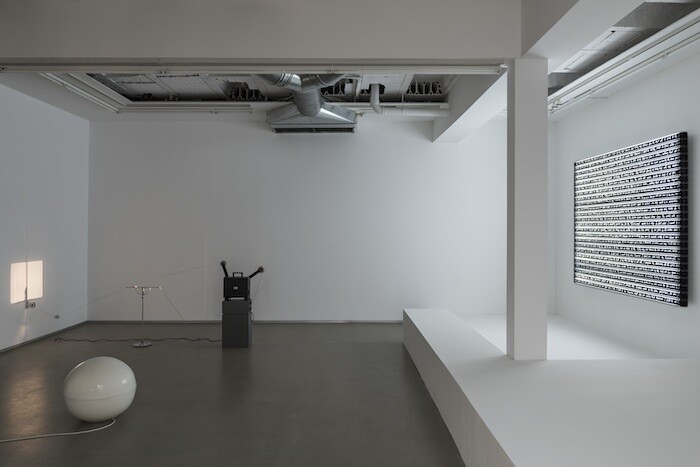Categories
Subjects
Authors
Artists
Venues
Locations
Calendar
Filter
Done
September 8, 2017 – Review
Nancy Holt’s “Holes of Light”
Helena Tatay

Nancy Holt’s works seem to be camouflaged in the hangar that hosts her Ibiza exhibition at Parra & Romero. This sense of spaciousness is relevant to Holt’s practice, who remains best known for her site-specific earthworks. Like many artists of the 1960s and ’70s, Holt was critical of the gallery system, and her pieces for indoor spaces are rare. The Ibiza exhibition displays two of the very few installations that were conceived for interiors or that could be activated in both interior and exterior spaces, such as Locator with Mirror (1972), the first piece visitors encounter upon entering. Holt’s “Locators” are steel vertical pipes that support shorter horizontal pipes that direct the viewer’s gaze towards a specific point—in this case, towards a mirror on the wall, which returns the viewer’s own image, a disruptive experience in an exhibition. The “Locators” are a seminal body of work; they include Missoula Ranch Locators: Vision Encompassed (1972), eight locators in a circle measuring 12 meters in diameter in the middle of a field surrounded by mountains in Montana, which was Holt’s first device in a natural landscape that framed vision to change reference points or scale.
The exhibition’s main installation, Holes of …
January 24, 2017 – Review
Luis Camnitzer’s “Dibujos”
Helena Tatay

The first paradox one encounters in Luis Camnitzer’s exhibition at Parra & Romero in Madrid is the apparent contradiction between its title, “Dibujos” [Drawings], and its content, two installations titled El Cuaderno Rayado [The lined notebook] and Dibujos en el Agua [Drawings on water]. Exhibited in separate gallery spaces, each installation is centered on a single object around which, through stories presented in printed texts, Camnitzer sketches out different realities.
El Cuaderno Rayado consists of a school notebook in a display case and 12 framed texts hung on the wall. The story narrated in the texts is always the same: in 1972, the artist “remade” a school notebook by drawing over the existing lines. The notebook was lost, and 40 years later he recreated it. The story is told 12 times from different angles, as performance; in relation to conceptual art and tautology; within the frame of realistic art; as cartography; in terms of the relationship between art and craft; and so on. After reading the texts, the viewer becomes aware of the second paradox, the second stimulus to reflection. By offering these differing accounts of the same event, Camnitzer sets up the issue without naming it: the nature of the …
April 19, 2016 – Review
Rosa Barba’s “Thoughts of Sorts”
Helena Tatay

Everything is in motion in the main room of Rosa Barba’s exhibition at Parra & Romero, Madrid. The mechanical buzz of film projectors is broken by the tack-tack of a slowed-down typewriter and the purr of an engine that rhythmically bursts out. Dimly illuminated by their own light, four mobile sculptural works seem preoccupied by their own looping performances.
Rosa Barba’s work encompasses films, sculptural moving objects, filmic installations, and text pieces that are grounded in the materiality, functions, and structures of cinema. Like Georges Perec—from whom the title “Thoughts of Sorts” is borrowed—Barba is interested in inventing new ordering systems: different ways to classify the world in order to understand it on its own terms. Both disrupt conventional, established hierarchies. Perec produces literature as an ars combinatoria from surprising classifications and through list-making, while Barba dismembers and reconfigures the material and structural elements of classical cinema to produce conceptual mobile sculptures that are unexpectedly dense and engaging.
Spacelength Thought (2012)—an antique typewriter on top of a projector—types text onto 16mm white film. The slightly burned letters are projected one at a time onto the wall. While this “author” poetically extends the production time of each word on the wall, the …
January 5, 2012 – Review
Luis Camnitzer’s “Reflejos y Reflexiones”
Lorena Muñoz-Alonso

After several years of teaching and working in printmaking, the Uruguayan artist Luis Camnitzer made what he considers to be his first conceptual piece. It was 1966: written in black plastic lettering over a white board, two sentences accosted the viewer, “This is a mirror. You are a written sentence.” Thus began Camnitzer’s enduring exploration of the symbolic qualities of the mirror. The piece also granted him entrance to the clique of emerging Conceptual artists—those exiled from South America in particular—that were gathering in New York, where he had moved to in 1964. Since then he has been something of an artist’s artist and a beacon for a younger generation of post-Conceptualists like Alejandro Cesarco or Stefan Brüggemann.
This relatively low profile seems to be changing at the not-so-tender age of 75. In 2011, Camnitzer had a survey exhibition at the Museo del Barrio in New York, which toured from the Daros Museum in Zurich. His show at Parra & Romero in Madrid marks his first solo show in Spain. The show is a tight retrospective of his long career through eight works, five of which are constructed around the figure of the mirror. Fittingly, the show’s title is “Reflejos y …